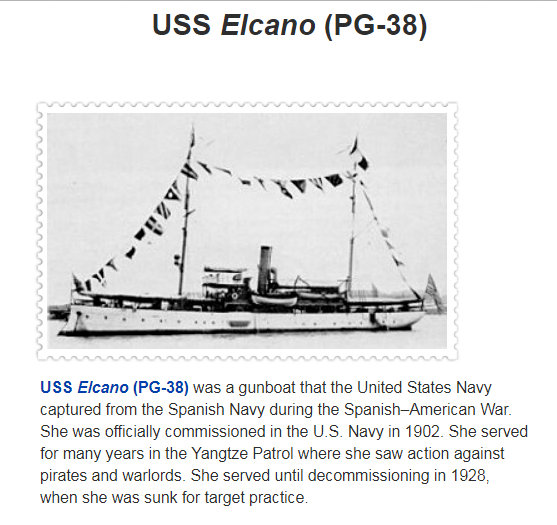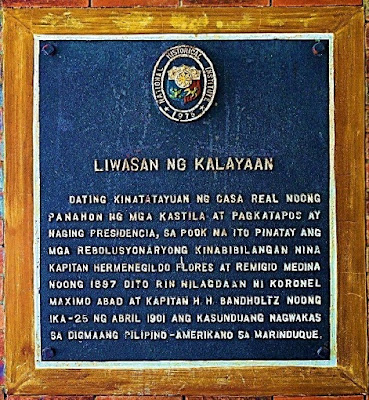 |
| (Above) It was this Spanish gunboat ELCANO that in a show of force aimed its cannons at the Bintakay mountain and fired. Photo: Wikipedia |
Remembering the first Revolutionary Heroes of Marinduque
by Eli J. Obligacion(First published in the Mogpog Mayflower Festival '98 Souvenir Program as excerpt from an unpublished work by Eli J Obligacion)
By 1896 the town of Mogpog was associated with an active resistance group headed by a native, Basilio Mendez. Mendez' unit was composed of about 25 men that included his brother Vicente and his sister Olympia. Other members were Bartolome Taingaso, Juan Manuba, Felix Lavega, Fabian Medenilla and Dalmacio Lamac.
Originally camped at Balanacan, they moved to Mt. Bintakay finding it more secure from attacks.
The Mendez unit was armed only with bolos and they had no guns. But out of iron scraps prototype cannon bullets were designed and made for an ingenuous "homemade wooden cannon".
The movements of the Mogpog unit sowed anxiety among the residents of the Boac-Mogpog area. Realizing that an encounter was imminent they feared getting caught in the middle of the two contending forces. Andres Arceo, Mogpog town chief, trying to avoid such an encounter sent a team of "sumatins" (local police volunteers), to the Mendez camp to enduce the revolutionists to give up their cause, but to no avail.
Members of the unit went on to gather huge stones and boulders, placing them in strategic locations where the enemy forces could ascend. Deep holes were dug and earth were piled around to serve as trenches.
The Spanish governor, Rafael Morales, gave the order to attack Mt. Bintakay on April 12. With an "alferez" (officer with rank of lieutenant), named "Lima" leading the "tercios" an ascent on the mountain was started. As the Spanish forces approached the summit, huge stones and boulders gathered by the unit rolled upon them. No one appeared to have been killed, but the attack was enough for an angry retaliation by the enemy forces.
MORE FORTIFICATIONS
Realizing this, the local unit engaged in fortifying their defense position further. Huge sharp rocks and boulders were arranged in line on all possible entry points. Grassy areas were stuck with "pasolos", pieces of bamboo ('anus' variety), tied together with their pointed edges projecting in all directions - the blade-sharp edges of the stuff would cut one's skin upon contact.
In the meantime, a piqued governor Morales in Calapan (Mindoro, which administers Marinduque), organized a bigger reinforcement. "Elcano", a Spanish gunboat anchored at the port of Laylay on the first week of June with a Company of Spanish marines and Morales himself. The Morales plan was to attack the camp with a bigger force composed of the Spanish marine company - a smaller company of "cazadores" and 50 "tercios and sumatins" combined.
GUNBOAT "ELCANO"
It was on June 7 when the "Elcano" navigated from Laylay to Loawan, dropping anchor in a position which offered the best view of Mt. Bintakay. In a show of force the "Elcano" aimed its cannons at the mountain and fired. But with tough luck, the erratic cannons missed and hit Mt. Buaya (now sitio Biyaya), instead. In mockery, the revolutionists blew their "budyong". Morales, now on horseback , gave the order to ascend the mountain. Kapitan Basilio Mendez then divided his men into two groups stationing them at strategic points, and waited.
The advancing forces were again met with sharp rocks, rolling boulders and bamboo spears thrown in their direction. Towards noontime the revolutionists fired their unique cannon. The loud explosion is said to have caused a dumfounded Morales to fall off his horse.
The revolutionists suffered one casualty and, before the assault forces could go near them, had withdrawn from their position. No one was captured. But their home-made cannon was left behind and the Spanish soldiers felt duped. The cannon which had created a feeling of dread upon the enemy forces was "a piece of wood more than a meter long and painted black, with an iron tube and using missiles made of small pieces of iron".
The Spanish force suffered heavily - from wounds inflicted by the bamboo "pasolos, others from lacerations caused by sharp stones hurled by the insurrectos, and Governor Morales had to be carried by his men". The Spanish force retired to Mogpog with the cannon carried by one man. In total dismay the Spanish sergeant named Perez ordered the piece destroyed. The attack was a fiasco.
 |
| Dramatization of Battle of Camarines, Bintakay presented at the first "Araw ng Marinduque" commemoration in 2008 by DepEd |
What transpired two days later was contained in a 1984 report by Magalang, et al, based on eyewitness accounts:
"Two days later, at noontime, the Spaniards led by governor Morales, attacked from the rear, catching Mendez and his men by surprise. Wading among the tall cogon grass the Spaniards were accompanied by the "tersios" and "sumatins", local volunteers and some townspeople. Mendez commanded his men to deploy, some taking cover in the holes they had dug, others behind big rocks.
"The enemy started firing until a hand-to-hand combat ensued; with the rebels fighting with their "niluglug" bolos against the Spanish guns. With some of his comrades fallen and he himself hit by a bullet in the left ear, Kapitan Mendez ordered a retreat. Diego Manuevo and a certain "Silvestre", who were the last rebels affront saved their lives by creeping down the steep slope".But it was not to be the last time the Spaniards would hear of the exploits of the unvanquished Mendez unit.
10 DE OCTUBRE
Sunday, 10 October 1897, was the "Feast of the Santo Rosario", a much awaited religious event in the town of Boac. The procession which started at 6:00 p.m. was unusually long. Shortly after the religious procession ended at 9:00 p.m. word was received by the Spanish lieutenant, Fresnede, that the "insurrectos" were on their way to Boac to attack the "Casa".
Fresnede was still assessing the report with his cazadores when the revolutionists from Mogpog, led this time by Fabian Medenilla ("Kapitan Fabian"), of the Mendez unit raided the Casa Real in Boac.
There, the last of their comrades-in-arms awaited their fate. The revolutionists fought with their bolos, the cazadores with their guns. The sounds of anguished cries and gunfire gripped the whole town. The ensuing pandemonium could only be sensed by the townspeople, too frightened and confused to immediately know what was happening.
Found dead the morning after by the door of a ground floor office of the Casa Real was Fabian Medenilla, a bullet hole embedded on his forehead. The bullet was fired off from the gun owned by Fresnede.
Together with the other dead prisoners inside the cell were found the lifeless bodies of Hermenegildo Flores* ("Bindoy") and Remigio Medina ("Kapitang Mio"), revolutionary leaders from Sta. Cruz and Torrijos, respectively. In ultimate mockery, the Spaniards decided that the fallen "insurrectos" were not worthy of a Christian burial, nor "Bendita" nor prayers nor shallow graves. The corpses of the two were hauled into the banks of the Boac river then covered with tree trunks and palm leaves. The bodies were burned and reduced to mere ashes.
But the corpses of the other revolutionists with support roles were better treated. These were brought to an old graveyard east of the town, on a small hill in Tampus that served as their final resting place. (Near the graveyard, one fallen body turned out to be still alive and, recovering consciousness, implored the "cazadores" to spare his life. He got more bullets instead).
1 DE NOVIEMBRE
 |
| Historical Marker sa Casa Real (Boac, Marinduque). Nasasaad dito ang pagkamatay nina Hermenegildo Flores at Remigio Medina noong 1897. |
It was to be the last direct and bloody assault on the Spaniards. There was fierce fighting in the dead of night, and the townspeople, in fear and prayer could only hear the gunshots and the cries of men. Mendez and his men were repulsed.
Then Fresnede, the Spanish lieutenant ordered those still in jail to be killed. A grim and ghastly silence echoed throughout the building and the now ghostly town.
One of the prisoners, mistaken for dead, was luckier this time. Pedro Madrigal, a pharmacist from Boac who was ordered to check the bodies informed Fresnede immediately. The prisoner, Juan Manuba of Mogpog, fighting for his dear life raced towards the Boac river, disappeared into the thick bushes and lived on to tell his story.
Also read:
